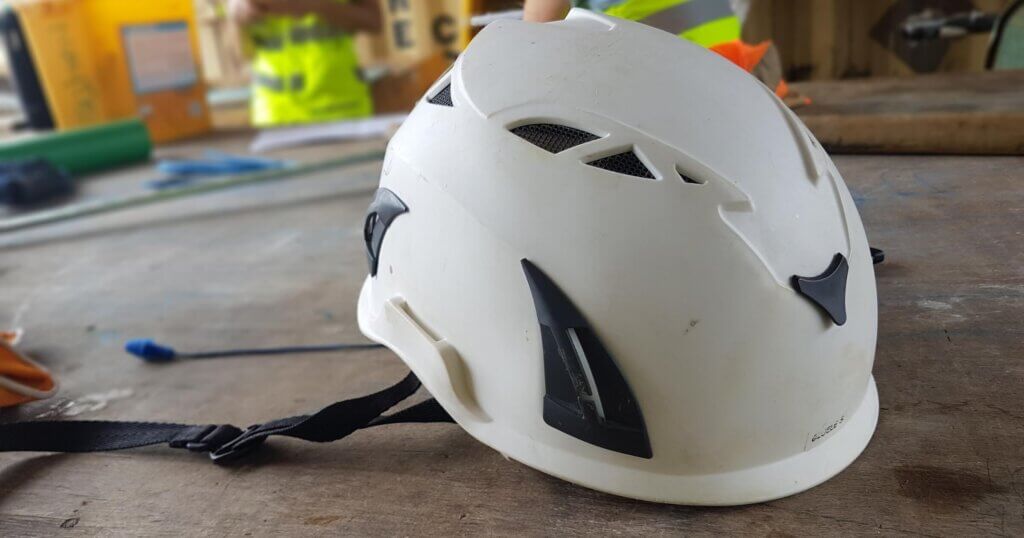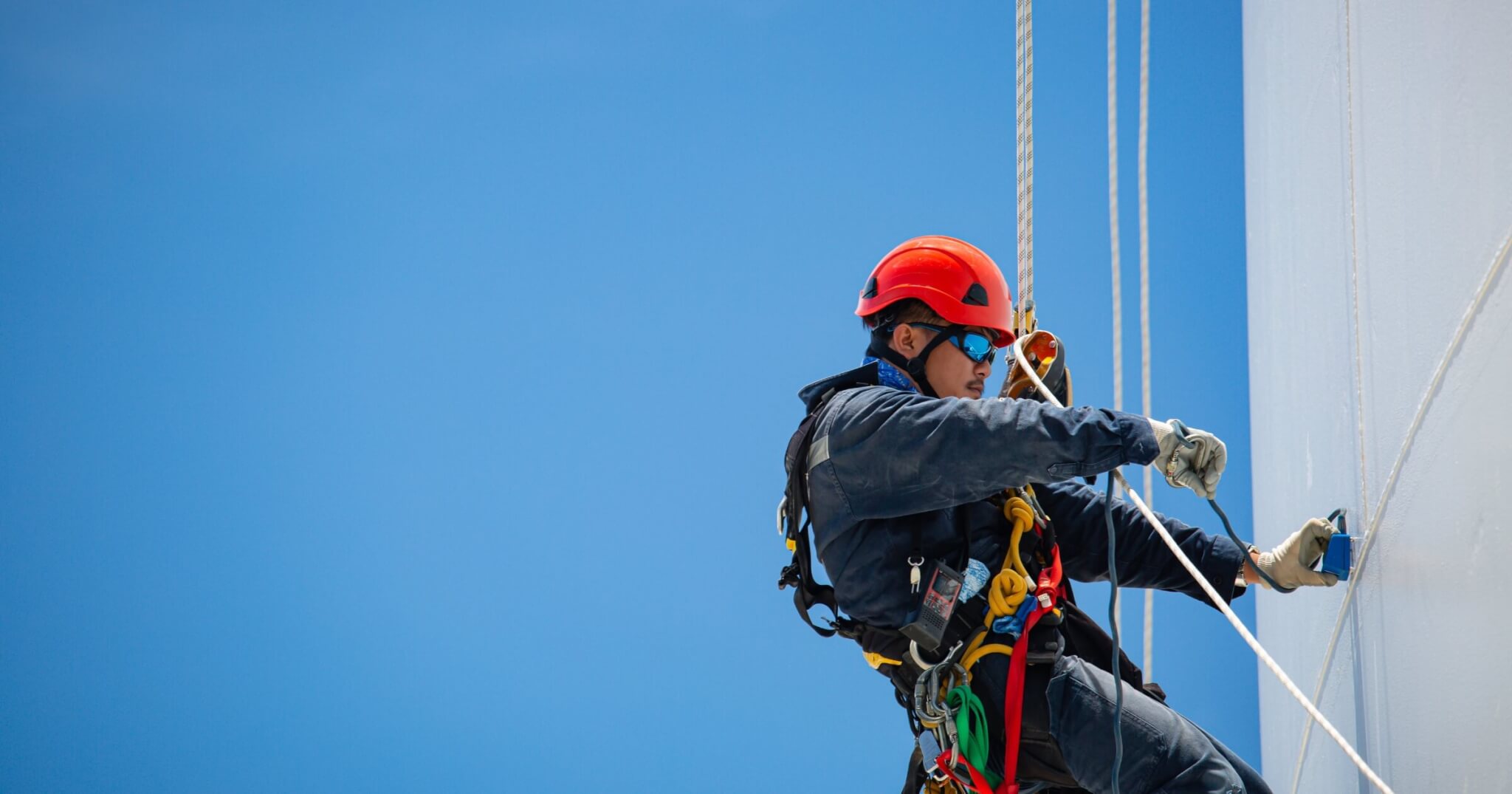The hard hat has long been a staple of the construction industry and is one of the most integral pieces of safety equipment on any job site. However, with the growing popularity of safety helmets comes fewer incidents, better protection, and less use of the traditional hard hat known so well today. Safety helmets are identifiable by their chin strap, and the different types and classes offer various ways of protecting your team.

What is a safety helmet?
A safety helmet is personal protective equipment (PPE) worn on the head to prevent injuries in the event of an incident. Often repurposed climbing helmets, safety helmets fit more snugly on the head and have a chin strap to keep them secure.
Many workers across the construction industry use “safety helmet” and “climbing helmet” interchangeably, and it’s most common to see workers exposed to great heights and fall hazards wearing these over a traditional hard hat. The topic of ground workers adopting safety helmets over hard hats has recently been under close debate.
Types of safety helmets
Head protection is generally rated with the same American National Standards Institute (ANSI) standard and can be broken down into two types and three classes within those types.
- Type I: protects workers from “top of the head” impact. These hard hats are commonly known as a budget option and are very popular across the industry.
- Type II: protects workers from both “top of the head” and lateral impact, including impact from the front, side, and back. These types of safety helmets have grown in popularity in recent years, and companies looking to upgrade from type I to type II are increasingly opting for type II safety helmets vs hard hat options.
Classes of safety helmets
- Class C hard hats (Conductive) are vented head protection but do not protect against electrical hazards.
- Class E hard hats (Electrical) provide the maximum protection against electrical voltage. Tested up to 20,000 volts, these helmets and hard hats have little to no venting, making them uncomfortable over a long period.
- Class G hard hats (General) provide some, but a limited amount of protection against voltage. They’re tested to only 2,200 volts and, like class E, have little to no vents. You’ll find that to have any substantial protection against electrical hazards, ventilation isn’t much of an option.
Safety helmet vs hard hat: Key differences
The main difference between a safety helmet and a hard hat is the chin strap. The chin strap is a simple but effective addition to any helmet PPE, as it prevents it from getting knocked out of place or completely off the head. The most advanced hard hat in the world is no good if it doesn’t stay on your head correctly.
This, however, doesn’t mean you could purchase any climbing helmet and use it on your construction site. While they do offer excellent protection against injury and impact, they aren’t specifically tested to meet EN or ANSI ratings.
Construction injuries cost companies more every year. Sourcing a safety helmet that meets the required safety standards for your jurisdiction will keep you from getting injured and increase your head protection.
How long does a safety helmet last?
Most head protection products have a shelf life of around 5 years. But it’s important to consider the manufacturer’s recommendations for your specific products. ANSI and OSHA advise this manufacturer’s rule of thumb.
However, there are visible indicators of when to swap to a new safety helmet.
When to start looking for a new helmet
It’s important to inspect your safety helmet regularly, as physical damage could render the helmet ineffective sooner than the manufacturer’s recommended expiry date. A few things to look for include:
- Damage to the chin strap: If it is frayed or the clasp doesn’t close, it could fall off or be knocked out of place, making it ineffective at absorbing impact.
- Damage to the shell: Any cracks or dents to the helmet’s shell could also make it less effective at absorbing impact and preventing workers from injury.
- It loses its glossy finish: Often, when a helmet is damaged thanks to UV radiation, the shell might lose its glossy finish, and it may even flake off. If this is the case, again, it could be ineffective at providing head protection and should be replaced.
Top safety helmet brands
Many brands on the market have stepped into the safety helmet ring. Notable brands include:
- Lift: Lift offers both hard hats and safety helmets. Safety helmets come vented and non-vented and start around the $155 USD mark.
- Studson: At a similar price point of $150 USD, Studson also makes a reliable, well-tested safety helmet. These helmets come vented, unvented, and in various brim sizes.
- Kask: Taking a different approach, Kask offers head protection for sport and construction safety. Buyers can filter products based on compliance standards like ANSI and CSA, and while they don’t list their prices online, buyers can inquire with their team.
- Grainger: Grainger has long been a Canadian staple for safety gear, and they offer a range of new safety helmets conveniently labeled with their type and class.
- PIP: PIP offers ten safety helmet options for buyers to choose from and handy comparison functionality so buyers can ensure they’re getting the exact product they need.
Bottom line
Head protection in the construction industry is evolving, and businesses everywhere are slowly turning to safety helmets over traditional hard hats. The chin strap functionality might seem slight, but it’s the difference between injury and safety in many scenarios.
Remember to swap your helmet out based on its expiry date and whether or not the shell or strap is visibly damaged. Companies like Kask, PIP, and Grainger have users covered with getting started, bringing your team one step closer to incident reduction.
Want more gear recommendations and safety tips? Follow us on LinkedIn and subscribe to the newsletter to stay in the loop about all things construction equipment.


